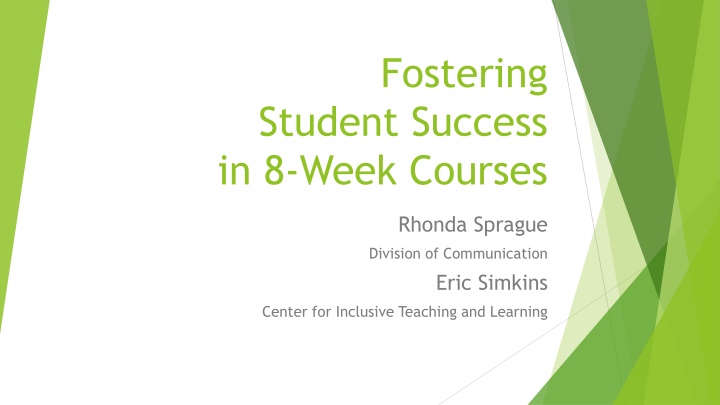
Maximizing Student Success in 8-Week Academic Courses
Explore strategies to enhance student success in 8-week courses, including advantages/disadvantages, workshop outcomes, considerations, and design recommendations for effective teaching and learning. Learn about the nuances of shorter course formats and how to ensure optimal learning outcomes within a compressed timeframe.
Uploaded on | 0 Views
Download Presentation

Please find below an Image/Link to download the presentation.
The content on the website is provided AS IS for your information and personal use only. It may not be sold, licensed, or shared on other websites without obtaining consent from the author. If you encounter any issues during the download, it is possible that the publisher has removed the file from their server.
You are allowed to download the files provided on this website for personal or commercial use, subject to the condition that they are used lawfully. All files are the property of their respective owners.
The content on the website is provided AS IS for your information and personal use only. It may not be sold, licensed, or shared on other websites without obtaining consent from the author.
E N D
Presentation Transcript
Fostering Student Success in 8-Week Courses Rhonda Sprague Division of Communication Eric Simkins Center for Inclusive Teaching and Learning
Workshop Outline Presentation (10 min) Q and A / Discussion (5 min) Work time (15 min) Q and A / Discussion (10 min)
Workshop Outcomes Recognize advantages and disadvantages of 8- week courses. Craft learning outcomes that reflect essential understandings for a course. Create a plan to determine whether an 8-week model will work for you. Know more about how campus resources can assist with a transition to an 8-week model.
Positives and Negatives of 8-Week Courses
Positives and Negatives of 8-Week Courses Negatives Positives Requires faster grading Fewer concurrent classes Students can feel overwhelmed Greater student concentration on task Requires good planning Requires good planning With limited time, everything seems essential Forces focus upon essentials Limited flexibility for students (e.g., when few 8-week offerings are available) Increased scheduling flexibility for instructors re: research / service If it is going badly, there is not as much time to improve. If it is going badly, it will be over a lot sooner.
Other Considerations Shorter add/drop periods Financial aid Refunds Withdrawals Credit loads/scheduling
Is This a Good Choice for Your Course? Work time and workload Instructor response time Processing time You really need to figure out, how am I going to make students be prepared to take this next step? Moon said. The next step is two days from now, not two weeks from now. (Lieberman, February 2019, para. 7) There are certain disciplines where you kind of need time to synthesize information before it becomes a skill, Leeman said. You need to take in a theory and a concept. You need time to percolate a little bit, and then it starts converting with conversations and activity. (Lieberman, January 2019, para. 17)
Design Recommendations Focus on outcomes then on content Determine the essentials remove the unnecessary Provide very clear instructions Think about response/feedback time Utilize peer-to-peer interactions & feedback Blend the edges At Arizona State, Moon adapted her half-semester online course from an existing semester-length course that s currently offered on ground. She realized during that process that her teaching strategy up to that point focused on coverage -- points A and Z, and everything in between, needed to be included in the curriculum. In a shorter course, she s more focused on outcomes - how to ensure that students leave the class having learned a set of knowledge and skills. It really forces faculty to identify what s essential in a course, and to trim the fat, Moon said. (Lieberman, February 2019, para. 4)
Workshop A. Essential Understandings / Learning Outcomes B. Alignment Course Mapping Sheet Module or Unit Planning Sheet C. Needs Tools Available Canvas Tools 1. 2. 1. Discussions A. Peer Reviews B. Quizzes (formative and/or summative) C. Calendar Events (as reminders) External Tools D. 2. YouTube, Vimeo, etc. A. Qualtrics Surveys B.
Bibliography Lieberman, M. (2019, January 30). The Long and Short of Online Courses. Inside Higher Ed. Retrieved January 8, 2020, from https://www.insidehighered.com/digital- learning/article/2019/01/30/institutions-experiment-shorter-online-courses- audience. Lieberman, M. (2019, February 13). Extending the Conversation on Online Course Length. Inside Higher Ed. Retrieved January 8, 2020, from https://www.insidehighered.com/digital- learning/article/2019/02/13/shorter-online-courses-offer-flexible- alternatives-students-pose.
